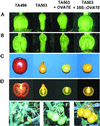A new class of regulatory genes underlying the cause of pear-shaped tomato fruit
- PMID: 12242331
- PMCID: PMC130628
- DOI: 10.1073/pnas.162485999
A new class of regulatory genes underlying the cause of pear-shaped tomato fruit
Abstract
A common, recurring theme in domesticated plants is the occurrence of pear-shaped fruit. A major quantitative trait locus (termed ovate) controlling the transition from round to pear-shaped fruit has been cloned from tomato. OVATE is expressed early in flower and fruit development and encodes a previously uncharacterized, hydrophilic protein with a putative bipartite nuclear localization signal, Von Willebrand factor type C domains, and an approximately equal 70-aa C-terminal domain conserved in tomato, Arabidopsis, and rice. A single mutation, leading to a premature stop codon, causes the transition of tomato fruit from round- to pear-shaped. Moreover, ectopic, transgenic expression of OVATE unevenly reduces the size of floral organs and leaflets, suggesting that OVATE represents a previously uncharacterized class of negative regulatory proteins important in plant development.
Figures





References
-
- Nothmann J. In: Handbook of Fruit Set and Development. Monselise S P, editor. Boca Raton, FL: CRC; 1986. pp. 145–152.
-
- Smartt J, Simmonds N W. Evolution of Crop Plants. Essex, U.K.: Longman; 1995.
-
- Ku H-M, Liu J, Doganlar S, Tanksly S D. Genome. 2001;44:470–475. - PubMed
-
- Ku H-M, Doganlar S, Chen K-Y, Tanksley S D. Theor Appl Genet. 1999;9:844–850.
-
- Hederick U P, Booth N O. Proc Am Soc Hort Sci. 1907;5:19–24.
Publication types
MeSH terms
Substances
Associated data
- Actions
LinkOut - more resources
Full Text Sources
Other Literature Sources
Molecular Biology Databases

